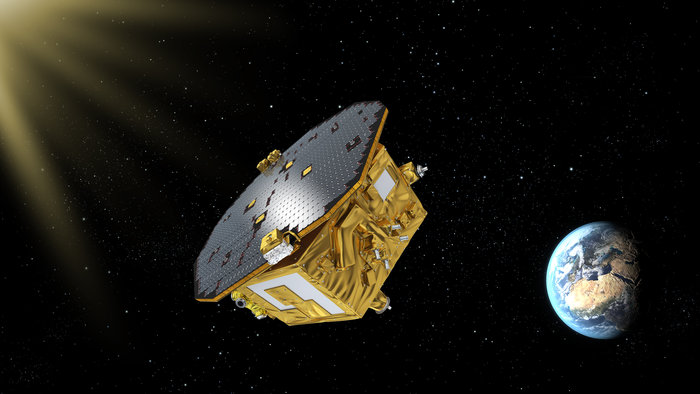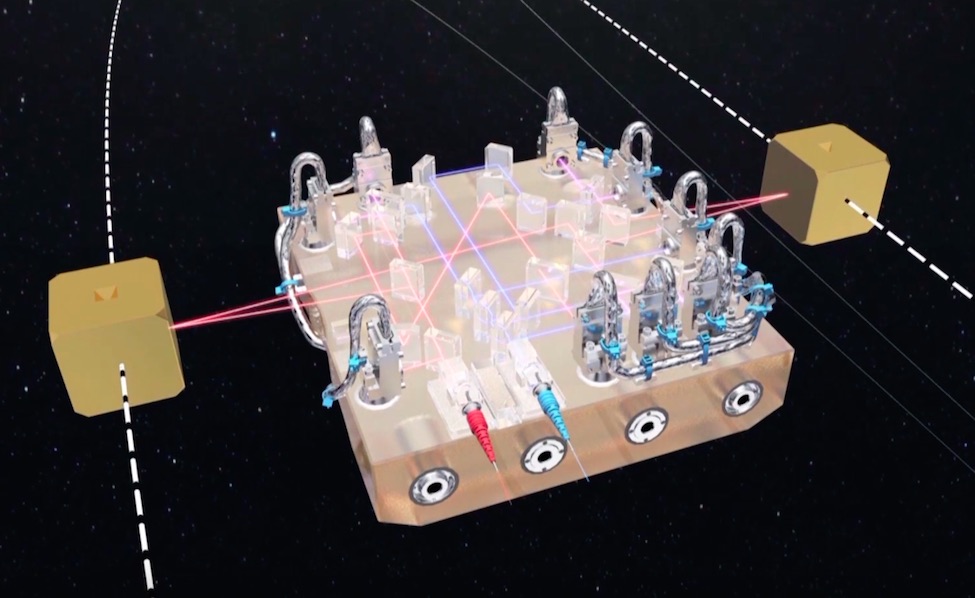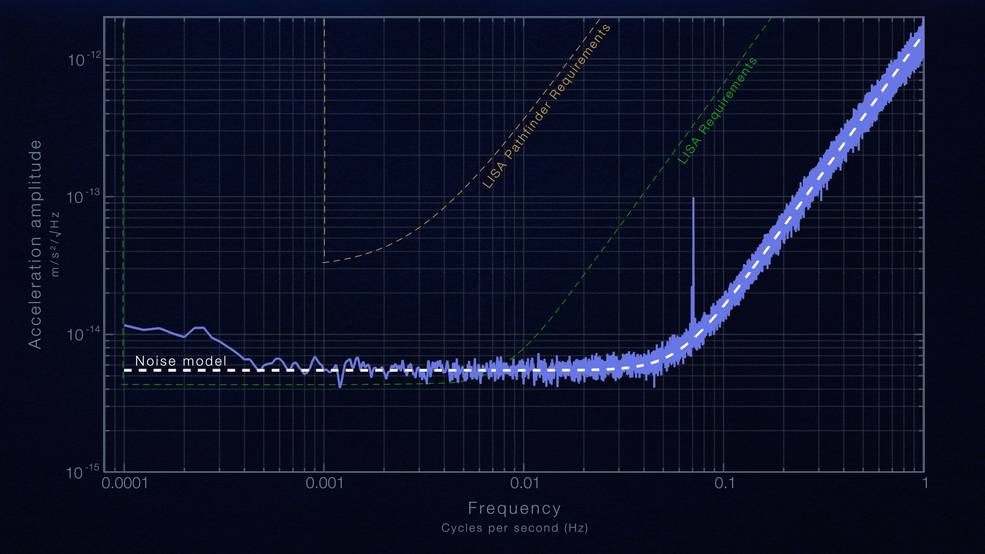
Europe’s LISA Pathfinder mission — a fundamental physics lab launched last year to a point a million miles from Earth — has demonstrated the mind-boggling technology required for a future space-based observatory to listen for faint, low-frequency vibrations emitted by invisible objects in the most distant pockets of the universe, scientists said this week.
Coupled with the first detection of gravitational waves last year by a ground-based antenna, the successful LISA Pathfinder experiment buoys ambitions to launch a billion-dollar observatory into interplanetary space by the 2030s to study the structure of the ancient universe by measuring how the waves propagate through the cosmos.
Predicted by Albert Einstein’s theory of general relativity a century ago, gravitational waves are ripples in the fabric of spacetime produced by the movement of massive objects in space, such as immense supermassive black holes at the centers of galaxies. The waves eluded discovery until last year, when the U.S.-led Laser Interferometer Gravitational-Wave Observatory, or LIGO, project detected a signal generated by two merging black holes about 1.3 billion light-years away.
Gravitational waves move through space at the speed of light, but are observed at very low frequencies, requiring an observatory spread over thousands or millions of miles. The LIGO project has antennas positioned 1,800 miles (3,000 kilometers) apart in Hanford, Washington, and Livingston, Louisiana.
Scientists are in the early stages of developing a mission for launch in the 2030s consisting of three spacecraft in orbit around the sun, placed 3 million miles (5 million kilometers) apart to improve sensitivity to gravitational waves.
The European Space Agency built the LISA Pathfinder spacecraft, with assistance from NASA, to prove such a space-based gravitational wave observatory is even feasible.
The answer is yes, scientists said Tuesday, and LISA Pathfinder’s performance is even better than expected.
“We now know gravitational waves are detectable — they exist — and thanks to LISA Pathfinder, we now know we have sufficient sensitivity to observe them from space, and therefore a new window to the universe has been opened,” said Fabio Favata, an astrophysicist and head of ESA’s science coordination office.
LISA Pathfinder launched in December on a month-and-a-half journey to orbit the L1 Lagrange point, a gravitationally-neutral location about 930,000 miles (1.5 million kilometers) from the Earth toward the sun.
The purpose of the $630 million mission, funded primarily by ESA with contributions from the United States, was to test the major advancements required in laser ranging, metrology and other fields to make a space-based gravitational wave observatory possible.
Two gold-platinum test cubes launched inside the LISA Pathfinder spacecraft were released in February from their launch restraints, a complicated procedure involving needle-like appendages that carefully pulled away from the cubes — each 1.8 inches (46 millimeters) on a side and with a mass of 4.4 pounds (2 kilograms) — to avoid disturbing them with electrostatic forces.

The crux of the mission was to prove the test cubes could be kept in a constant state of nearly perfect free fall during LISA Pathfinder’s six-month mission, which formally began in March.
The LISA Pathfinder spacecraft — smaller than a compact car — employed low-impulse cold gas nitrogen thrusters to essentially fly around the free-floating test masses suspended inside two vacuum enclosures placed 15 inches (38 centimeters) apart on the satellite.
Accelerometers aboard LISA Pathfinder precisely track its movements, and a control computer sends signals to the low-thrust rocket packs outside the probe to continuously correct to keep the test cubes from contacting the walls of their chambers.
“It’s a technology that is not easy,” said Alvaro Gimenez, ESA’s director of science, before LISA Pathfinder’s launch in December. “You have to have thrusters to compensate, and you have to have systems to measure the compensation you have to apply, all this at a level of precision that has never been done before. This is why LISA Pathfinder is a technologically unique mission.”
LISA Pathfinder kept the test masses in free fall five times more precisely than necessary, according to Martin Hewitson, LISA Pathfinder senior scientist from the Max Planck Institute for Gravitational Physics and Leibniz University Hannover in Germany.
“LISA Pathfinder’s test masses are now still with respect to each other to an astonishing degree,” Gimenez said in a statement. “This is the level of control needed to enable the observation of low-frequency gravitational waves with a future space observatory.”
The mission formally began science operations March 1, and scientists immediately realized the technology package worked almost flawlessly.
“The measurements have exceeded our most optimistic expectations,” said Paul McNamara, LISA Pathfinder’s project scientist at ESA. “We reached the level of precision originally required for LISA Pathfinder within the first day, and so we spent the following weeks improving the results a factor of five.”
A high-precision laser interferometer constantly measures the range between the two test cubes, and that device also exceeded requirements.
“The goal was to be able to measure their motion changes on the timescales of minutes to hours at the picometer level,” Hewitson said Tuesday. “This is a millionth of a millionth of a meter. This is a tiny fraction of the size of an atom.”
It turns out LISA Pathfinder did better, measuring the relative motion of the test masses with a precision of a femtometer, or ten millionths of a billionth of a meter.
LISA Pathfinder is 10,000 times more stable than any satellite flown on a previous science mission, officials said.

The LISA Pathfinder team published their results based on the mission’s first two months of data this week in Physical Review Letters.
The European Space Agency authorized full development of LISA Pathfinder in 2004, with a launch then expected in 2008. Technical challenges with the craft’s control thrusters, and the caging mechanism designed to protect the test cubes during launch, forced a mission delay.
LISA Pathfinder gets its name from the Laser Interferometer Space Antenna project, a gravitational wave observatory concept studied by ESA and NASA. An ESA science panel in 2013 decided to pursue development of a new X-ray astrophysics observatory for launch in 2028, followed by a space-based gravitational wave detector similar to the LISA proposal in 2034.
The LIGO antennas are tuned to register gravitational waves around 100 hertz, but an observatory in space could detect the ripples at frequencies as low as 0.1 millihertz, yielding insight into a wider range of cosmic phenomena that produce the waves.
Lower-frequency gravitational waves come from more powerful events, such as the collision of two supermassive black holes at the centers of galaxies, according to ESA.
The European-led gravitational wave observatory planned for launch around 2034 will include three spacecraft positioned 3 million miles (5 million kilometers) apart in solar orbit. High-energy lasers, focused with telescopes, will link the spacecraft to look for tiny changes in the distance between the observatory’s three nodes.
“Gravitational waves induce very small motions on matter, and it’s this mind-boggling small motion that we need to detect,” Favata said. “To actually measure gravitational waves, we must track their motions to a fraction of an atomic radius — a very small number — of masses of this (46-millimeter) size positioned millions of kilometers distant on different spacecraft.”
The reference cubes inside each craft have to remain in free fall, undisturbed by any force except gravity.
Asked whether the experience with LISA Pathfinder could accelerate the launch of the gravitational wave observatory, Favata said the ambitious mission — expected to cost between $1 billion and $2 billion — still has many hurdles to jump.
“Clearly, the mission we are celebrating today is a key step in the development of the technology for the gravitational wave observatory, but there are other technologies that are not yet there,” Favata said. “Lasers, in particular the laser necessary to communicate between two spacecraft at 5 million kilometers, is a laser which has never been built before. The level of frequency accuracy and power is not there. It is something we need to develop.
“Those laser beams need to be focused by telescopes because you need to shine one for 5 million kilometers and receive it by the other spacecraft,” Favata said. “The telescope needs to have an amazing dimensional stability. You have heard all sorts of femto, micro, and nano words, which means everything must be very stable, so if the telescope that beams your laser moves around because of thermal expansions or because of other issues and imperfections, you still mask the signal.”
At the lowest frequencies probed by LISA Pathfinder — below 1 millihertz — scientists measured a small centrifugal force acting on the test cubes. Experts attribute the noise to the shape of LISA Pathfinder’s orbit and interference from the spacecraft’s star trackers used to maintain its orientation, according to ESA.
From 1 millihertz to 60 millihertz, residual gas molecules left in the test cube chambers inside LISA Pathfinder bounce off the surface of the gold-platinum masses, imparting a very slight force. Scientists said the noise level in this frequency range improved as controllers sent commands for LISA Pathfinder to vent as much air as possible out of the test cube enclosures.
Developers even had to account for cosmic rays, which can transfer an electric charge to the test cubes and skew results. Engineers added ultraviolet lights to the LISA Pathfinder technology suite to prevent such a charge from building up on the test masses.
“Not only do we see the test masses as almost motionless, but we have identified, with unprecedented precision, most of the remaining tiny forces disturbing them,” said Stefano Vitale, principal investigator of LISA Pathfinder’s technology package from the University of Trento in Italy.
McNamara told reporters Tuesday that the current phase of LISA Pathfinder’s mission will continue through the end of June, followed by a switch to U.S.-provided control system to test an alternative way of operating the spacecraft.
The NASA experiment involves efficient, low-power electric thrusters and an independent computer. NASA wants to test its own way of controlling LISA Pathfinder to showcase other technologies that could be employed on a future gravitational wave mission.
The U.S.-made electrospray thrusters, which will steer LISA Pathfinder during can point the satellite with the precision equivalent to the width of the double helix in a strand of DNA.
LISA Pathfinder’s performance puts astronomers and cosmologists a step closer to studying the universe in a fundamentally different way.
“The interesting thing with a gravitational wave observatory is you do not observe in the sense that you do not point the telescope somewhere,” Favata said. “It is like an omni-directional microphone. You hear everything that happens.”
“At the precision reached by LISA Pathfinder, a full-scale gravitational wave observatory in space would be able to detect fluctuations caused by the mergers of supermassive black holes in galaxies anywhere in the universe,” said Karsten Danzmann, director at the Max Planck Institute for Gravitational Physics and a LISA Pathfinder co-investigator.
Such research could be groundbreaking.
‘Those mergers of black holes are thought to have to determined the whole evolution of the structure of the universe,” Favata said. “It is something which is not seen. It is something which is postulated theoretically, and it hangs over our entire understanding of how the universe evolved from a gas cloud into the highly-structured thing that we see today with galaxies, clusters of galaxies and a whole hierarchical structure.”
Email the author.
Follow Stephen Clark on Twitter: @StephenClark1.



